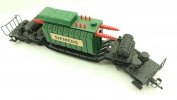ARIA31
Registered
I am interested to know what is the purpose of the hardware installed in front and the rear of the prototype version of the LGB wagon ref.4058
I suspect this is additionnal braking capability.
However somebody can explain me how it works on a real wagon ?
Why a so big reservoir ? How it is filled ? What are these 2 drums for ?
Thank you in advance

I suspect this is additionnal braking capability.
However somebody can explain me how it works on a real wagon ?
Why a so big reservoir ? How it is filled ? What are these 2 drums for ?
Thank you in advance


